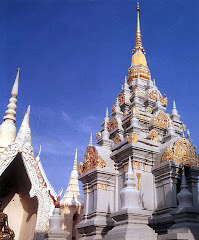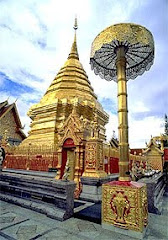 Wat Suwandararam was built in very late Ayutthaya Period by the Father of King Rama I of Ratanakosin. The temple was then named "Wat Thong". The temple has been well looking after by the Kings of Rattanakosin Period.
Wat Suwandararam was built in very late Ayutthaya Period by the Father of King Rama I of Ratanakosin. The temple was then named "Wat Thong". The temple has been well looking after by the Kings of Rattanakosin Period.
In the ordination hall at Wat Suwandararam there are mural paintings which were painted to order of many Kings. King Rama IV of Rattanakosin had ordered the painters to paint scenes from the Chronical. In this picture the scene of King Naresuvara declaring independent from the Burmese. [ This masterful mural in ordination hall of Wat Suwandararam, Ayutthaya, shows the brave King Naresuan on elephant back defeating the Burmese Crown Prince (Phra Mahauparacha) in 1592 ]
[ This masterful mural in ordination hall of Wat Suwandararam, Ayutthaya, shows the brave King Naresuan on elephant back defeating the Burmese Crown Prince (Phra Mahauparacha) in 1592 ]
Related tags : Wat Suwandararam /Ayutthaya /Ayutthaya Period /Rattanakosin Period /Thailand Temple
/mural paintings
Tuesday, October 30, 2007
Wat Suwandararam : Ayutthaya
Posted by
myplot'blog
at
5:12 AM
1 comments
![]()
Labels: Ayutthaya, Mural painting, thailand temple, Wat Suwandararam, wat thai
Reclining Buddha at Wat Lokayasutharam : Ayutthaya
 [ photo credit to thai-tour.com]
[ photo credit to thai-tour.com]Related tags : Wat Lokayasutharam /Ayutthaya /thai temple /reclining Buddha /Thailand Temple
Posted by
myplot'blog
at
4:06 AM
0
comments
![]()
Labels: Ayutthaya, Buddha image, Reclining Buddha, Wat Lokayasutharam, wat thai
Wat Phananchoeng : Ayutthaya

Wat Phananchoeng is in the southern part of the city near the river. It was built in 1324 A.D., 26 year before king U-thong founded Ayutthaya, although it is not known by whom this temple was built. Phra Chao Phananchoeng, a large sitting Buddha constructed of brick and mortar, has been well known of a long time. King Naresuen the Great repaired it once, and the other Kings of Ayudhya must keep it in good repair too, though no mention is made of that in the chronicle, from which it is learnt only that when Ayudhya was taken by the Burmese tears flowed from the eyes of this image.
Later on the first king of the Chakri Dynasty and some of his successors repaired the image and towards the end of 1854 A.D., King Mongkut completely renovated the image and renamed it Phra Bhudh-trai-ratana nayok. On the 21st December 1901, during the reignof King Chulalongkorn, the outer garment of Phra Chao Phanan-cheng caught fire and the image was damaged in many places. King Chulalongkorn commanded the image to be repaired, and the work was finished in 1902 A.D.
On the 15th March 1928 the cheeks and the lower jaws of the image broke into pieces. The Royal Institute had it repaired in 1929. At that time Phra Dhamatri-lok the abbot of this monastery, on collecting the bits of gold leaves left by the devotees inside the Vihara gathered 165 grammes of that metal, 690 grammes of gold were contributed by others. With these 855 grammes of gold the head of the monastery made an "Una-lom" (ornament for the forehead substituted it for the older one which was of copper plated with gold).

Phra Chao Phananchoeng is held in respect by the Thai people who, when they visit ayutthaya, offer worship to this image and obtain prediction of their luck from its Vihara. Tourists who do not visit this temple miss the opportunity of seeing one of the very large, old and beautiful images. No Photographs of this image too are to be found in any book or even in the National Museum, where there is a collection of photographs of all other important images of the Buddha, because there is not enough room within the Vihara to set the camera at the proper distance to get a complete picture of this large image.
Phra Chao Phananchoeng is an image in the posture of subduing Mara. It measures 14 meters and 25 centimeters from knee to knee and 19 meters high (including the ornament above the head).
source: AYUTTHAYA
Related tags : Wat Yai Chai Mongkol /Ayutthaya /Wat Phananchoeng /wat /Thailand Temple
Posted by
myplot'blog
at
3:24 AM
0
comments
![]()
Labels: Ayutthaya, thai temple, thailand temple, Wat Phananchoeng, wat thai
Thursday, October 11, 2007
Wat Indravihan: Bangkok

 Located in Bangkhunphrom area on Wisutkrasat Road, Wat Indravihan is well-known for a huge standing Buddha image. Thai image of ''Buddhasiariyametriya'', is 32 metres tall (108.99 feet) and 10 metres and 24 inches wide (40.09 feet).
Located in Bangkhunphrom area on Wisutkrasat Road, Wat Indravihan is well-known for a huge standing Buddha image. Thai image of ''Buddhasiariyametriya'', is 32 metres tall (108.99 feet) and 10 metres and 24 inches wide (40.09 feet).
This Buddhist monument was built during the reign of King Rama IV. The topknot of the Buddha image contains a relic of Lord Buddha brought from Sri Lanka. The temple is open to the public every day. There is no admission fee.
Related tags : Wat Indravihan/Buddha image/Bangkok/Thailand Temple/Wat Thai
Posted by
myplot'blog
at
8:30 PM
0
comments
![]()
Labels: Bangkok, Buddha image, temple, Thailand, Wat Indravihan
Wat Chantharam or Wat Tha Sung : Uthai Thani Province


This old temple was built in Ayuthaya period. It was very decayed and rotten. Then one day Pra Rajpromyanthera (Luang Po Rusi Lingdum) came to this temple. He developed it to be the most famous and exquisite temple in Uthaithani province. There are Viharn Kaew (Glass Building) , Prasart Thong-kam (Golden Castle) , both of them are very exquisite and elaborate architecture. You can feed thousands of fish here.
source:
http://www.uthaithani.go.th
Related Tags:
Wat Chantharam/temple/thai temple/Wat Tha Sung/Wat Thai/Thailand
Posted by
myplot'blog
at
8:14 PM
0
comments
![]()
Labels: Buddhist temples, thai temple, Uthai Thani, Wat Chantharam, wat thai
Wednesday, October 3, 2007
Wat Uposatharam (Wat Bost) : Uthai Thani Province

This monastery is situated on Ko Thepho opposite to Uthai Thani Province Market, commonly called by the residents as "Wat Bot". The early Rattanakosin period mural paintings on the walls of the main shrine hall are regarded as very beautiful. Paintings of divine being are on the upper part while scenes from the life of the Lord Buddha decorate the lower part of the wall.
Related Tags: Thai Murals Painting/Wat Uposatharam/ Uthai Thani/Thai painting/Mural Painting
Posted by
myplot'blog
at
4:14 AM
0
comments
![]()
Labels: Mural painting, thai painting, Wat Uposatharam, wat thai
Phra Rabiang (The cloister or Galleries) : Wat Phra Kaew
The Royal Chapel is surrounded on four sides by cloister-like gallerie. It was constructed in the late 18th century during the reign of King Rama I, and has a total of seven portals. Of these, the two most often used are each equiped with a disrobing pavilion and its attached palanquin-mounting platform: one is located to the west of the gallery opening onto the Palace grounds; the other is on the east and leads to the Swatdi-Sopha Gate and out into the city.
These pavilions served for the king to change from his monarchal attire into suitable garments for worship prior to entering the precincts of the Chapel, and to change back on his way out. Another note-worthy portal is the Sirattana Satsada Gate to the south of the Gallery. This portal opens onto the inner court of the Grand Palace. It was through this portal that the ladies of the Palace used to make their way to the Royal Chapel for worship, merit-making and other religious ceremonies.

The gallery is noted for its murals depicting the entire Ramakian (the Thai version of the Ramayana epic). The verses telling the story of the painting are inscribed on marble slabs imbedded on the four sides of each pillar supporting the gallery roof. There are 4,984 verses altogether. Though originally painted when the Gallery was built, the murals as seen today reflect little of the art of the First Reign because the chronic dampness that affected the walls of the Gallery caused rapid deterioration and peeling of the murals, necessitating frequent restorations throughout the two centuries of their existence.
Conservations was carried out during the Third, Fourth and Fifth Reigns but it is not certain whether the murals were nearly retouched or entirely repainted. For the 150th Anniversary of Rattanakosin in A.D. 1932 the paintings were white-washed over and painted anew. The most recent restoration was done in the present reign; starting in 1965, it took seven years to complete, and modern technology was employed in an attempt to prevent future humidity problems.
source: http://www.geocities.com/RainForest/7153/pakao22.htm
Related tags : Wat phra kaew /Bangkok /Ramakien /Mural painting /Wat/Thailand Temple/thai temple
Posted by
myplot'blog
at
3:08 AM
0
comments
![]()
Labels: Bangkok, Mural painting, Ramakien, thai temple, thailand temple, wat phra kaew











